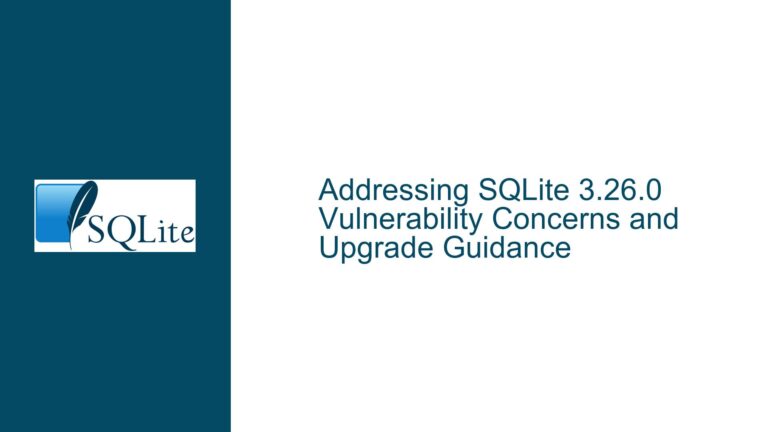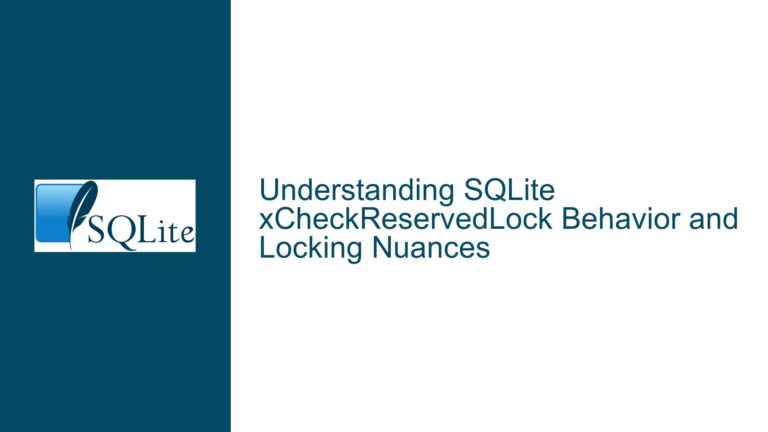Integer Overflow Risk in SQLite3 Changes Counter and Mitigation Strategies
Understanding the Integer Overflow Risk in SQLite3 Changes Counter
The core issue revolves around the potential for integer overflow in SQLite’s internal counters, specifically the sqlite3_changes() function and its underlying counter, nChange, within the sqlite3 struct. These counters are used to track the number of rows affected by the most recent SQL statement and the total number of rows affected since the database connection was opened, respectively. Both counters are implemented as 32-bit signed integers (int), which means they have a maximum value of INT_MAX (2,147,483,647 on most systems). When the number of affected rows exceeds this limit, the counter wraps around to a negative value, leading to incorrect results.
This issue is particularly relevant for large-scale databases where operations such as DELETE, UPDATE, or INSERT might affect more than INT_MAX rows in a single transaction. The discussion highlights a specific example where a DELETE operation on a table with more than INT_MAX rows results in the changes counter wrapping around to a negative value. This behavior is not only misleading but could also cause logical errors in applications relying on these counters for accurate row change tracking.
The problem is exacerbated by the fact that SQLite does not inherently limit the number of rows that can be modified in a single transaction. While the database can handle tables with billions of rows, the internal counters used to track changes are not designed to handle such large numbers without overflow. This discrepancy between the database’s capacity and the limitations of its internal counters creates a significant risk for applications operating at scale.
Causes of Integer Overflow in SQLite3 Changes Counter
The root cause of this issue lies in the design of SQLite’s internal counters. The sqlite3_changes() function and its underlying nChange counter were originally implemented using 32-bit signed integers, likely due to historical reasons and the assumption that most operations would not affect more than INT_MAX rows. However, as databases have grown in size and complexity, this assumption has become increasingly outdated.
The overflow occurs because the counters are incremented for each row affected by an operation. When the number of affected rows exceeds INT_MAX, the counter wraps around to a negative value due to the limitations of 32-bit signed integer arithmetic. For example, if a DELETE operation affects 2,147,483,648 rows, the changes counter will wrap around to -2,147,483,648, as demonstrated in the discussion.
Another contributing factor is the inconsistency in how SQLite handles 64-bit integers across its API. While some functions, such as sqlite3_total_changes64(), have been introduced to address this issue, others, such as the SQL total_changes() function and the shell’s .changes on display, continue to use 32-bit integers. This inconsistency can lead to misleading results, particularly on 32-bit architectures where 64-bit integers are not natively supported.
The issue is further compounded by the lack of built-in mechanisms to detect or prevent overflow. SQLite does not automatically truncate transactions at INT_MAX rows, nor does it provide a specific error code to alert applications to potential overflow. As a result, developers must manually implement safeguards to handle large-scale operations, which can be error-prone and inefficient.
Mitigating Integer Overflow in SQLite3 Changes Counter
To address the integer overflow risk in SQLite’s changes counter, several strategies can be employed. These include updating the internal counters to use 64-bit integers, modifying the SQLite shell to display 64-bit change counts, and implementing application-level safeguards to detect and handle large-scale operations.
1. Updating Internal Counters to Use 64-bit Integers
The most effective solution is to update the internal counters to use 64-bit integers (int64_t). This would allow the counters to handle up to 9,223,372,036,854,775,807 rows, effectively eliminating the risk of overflow for all practical purposes. The discussion mentions that a remedy has been implemented in the SQLite source code, with new functions such as sqlite3_changes64() and sqlite3_total_changes64() being introduced to support 64-bit change counts.
Developers using the latest version of SQLite can take advantage of these new functions to ensure accurate row change tracking. For example, instead of calling sqlite3_changes(), applications should call sqlite3_changes64() to retrieve the number of rows affected by the most recent SQL statement. Similarly, sqlite3_total_changes64() should be used to retrieve the total number of rows affected since the database connection was opened.
2. Modifying the SQLite Shell to Display 64-bit Change Counts
The SQLite shell’s .changes on display should also be updated to use 64-bit integers. Currently, the shell displays 32-bit change counts, which can lead to misleading results when the number of affected rows exceeds INT_MAX. The discussion highlights this issue and suggests that the runOneSqlLine function in src/shell.c should be modified to call sqlite3_changes64() and sqlite3_total_changes64() and print 64-bit integers.
Developers who build SQLite from source can apply these changes to their local builds to ensure accurate change count reporting in the shell. Alternatively, they can wait for the next official release of SQLite, which is expected to include these updates.
3. Implementing Application-Level Safeguards
In addition to updating the internal counters and the SQLite shell, developers should implement application-level safeguards to detect and handle large-scale operations. This can include monitoring the number of rows affected by each operation and taking appropriate action if the number approaches INT_MAX.
For example, applications can use the sqlite3_changes64() function to retrieve the number of rows affected by an operation and compare it to INT_MAX. If the number of affected rows is close to INT_MAX, the application can split the operation into smaller transactions to avoid overflow. Alternatively, the application can log a warning or raise an error to alert the user to the potential for overflow.
4. Handling Overflow in Existing Applications
For applications that cannot be updated to use the new 64-bit functions, it is important to handle overflow gracefully. This can include checking the return value of sqlite3_changes() for negative numbers, which indicate that the counter has wrapped around. If a negative value is detected, the application can assume that the actual number of affected rows is greater than INT_MAX and take appropriate action.
For example, if a DELETE operation returns a negative change count, the application can calculate the actual number of affected rows by adding INT_MAX + 1 to the negative value. This will give the correct number of rows affected, taking into account the overflow.
5. Ensuring Consistency Across the API
Finally, it is important to ensure consistency across the SQLite API when it comes to handling 64-bit integers. The discussion points out that the SQL total_changes() function and the shell’s .changes on display are inconsistent with the new 64-bit functions. Developers should update these components to use 64-bit integers to avoid misleading results.
For example, the total_changes() function should be updated to call sqlite3_total_changes64() and return an int64. Similarly, the shell’s .changes on display should be updated to call sqlite3_changes64() and sqlite3_total_changes64() and print 64-bit integers. These changes will ensure that all parts of the SQLite API provide accurate and consistent results, even for large-scale operations.
Conclusion
The integer overflow risk in SQLite’s changes counter is a significant issue for applications operating at scale. By updating the internal counters to use 64-bit integers, modifying the SQLite shell to display 64-bit change counts, and implementing application-level safeguards, developers can mitigate this risk and ensure accurate row change tracking. Additionally, ensuring consistency across the SQLite API will help avoid misleading results and improve the overall reliability of the database. With these strategies in place, developers can confidently use SQLite for large-scale operations without worrying about integer overflow.






